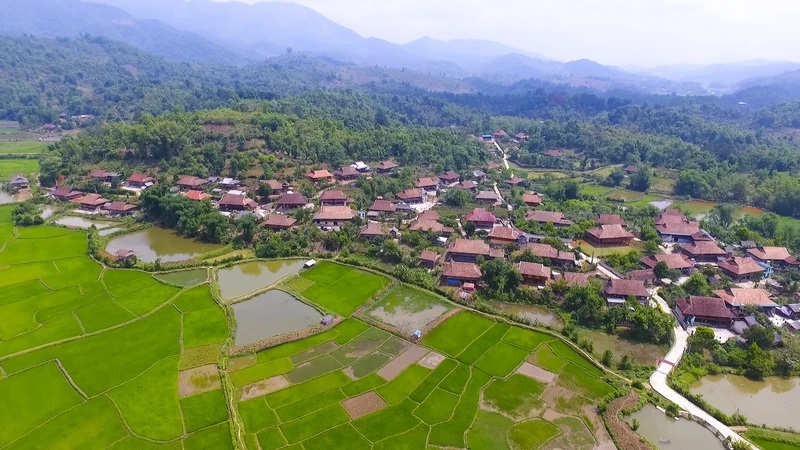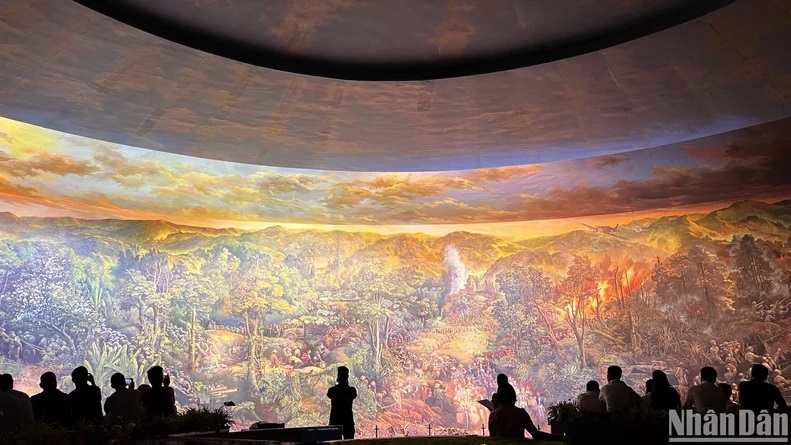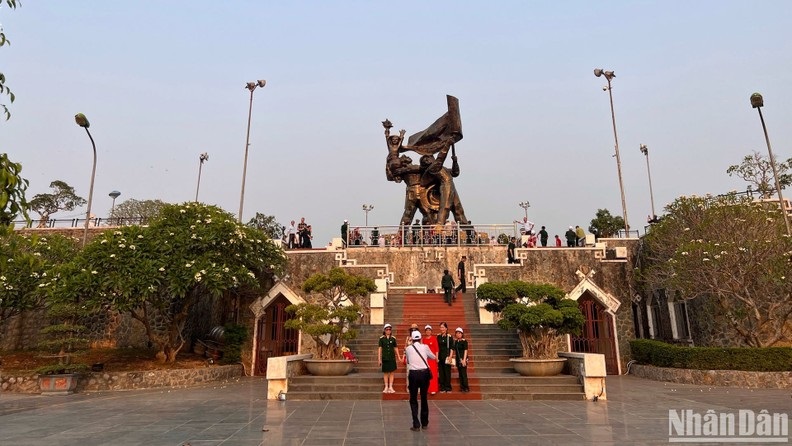Dien Bien tourism is a journey to help visitors not only review the glorious history of the nation through the Dien Bien Phu Victory, which “resounded throughout the five continents and was world-shaking”, but also have the opportunity to admire the majestic beauty of the Northwest’s mountains and forests and learn about the unique cultural identity of 19 ethnic groups.

Che Can cultural hamlet, an outstanding community tourism destination in Dien Bien Province (Photo: NDO)
For visitors to Dien Bien for the first time and want to explore most of the outstanding destinations, the four-day three-night journey (or three-day two-night journey) is a suitable and popular choice.
Overview of Dien Bien Tourism
Dien Bien is a mountainous province in the Northwest region, about 450km from Ha Noi, bordering Son La and Lai Chau as well as sharing an international border with China and Laos. It comprises 10 administrative units: Dien Bien Phu City (the provincial capital), Muong Lay Town, and eight districts.
With a tropical monsoon climate in the highlands, Dien Bien is influenced by the dry and hot southwest monsoon (often called the Lao wind). Dien Bien has rich potential for cultural-historical tourism and ecological and community tourism.
The most favoured times to visit Dien Bien are spring and early summer, when the weather is pleasant and without rain; flowers such as peach blossom, cherry blossom, bauhinia, flamboyant and giant crape-myrtle are in full bloom; and a variety of traditional festivals and activities to celebrate the Dien Bien Phu Victory (May 7) take place.
Transportation
By road: There are passenger vans running to Dien Bien from Ha Noi and some northern provinces. To save time, visitors from Ha Noi are advised to take overnight buses departing from My Dinh, Giap Bat, or Yen Nghia bus stations, with ticket prices of 300,000-500,000 VND per trip; travel time is about 10 hours.
Visitor using private vehicles can follow directions via online maps along National Highways 6, 32, or 37.
By air: Dien Bien has Dien Bien Airport (formerly Muong Thanh Airport, located in Dien Bien Phu City). Currently, only Viet Nam Airlines operates the Ha Noi-Dien Bien Phu route, with a flight time of around 55 minutes.

The mural painting with unique aesthetic and historical value (Photo: NDO)
Accommodation
Dien Bien Phu City offers a wide range of three-to-four-star hotels with large capacity, such as Muong Thanh Hotel, A1 Hotel, Nam Rom, Phuong Nam, An Loc, Guest House of the Provincial Party Committee, the Trade Union Hotel, and Him Lam Resort Eco-tourism Area. Additionally, there are motels within residential areas and near tourist sites, with prices ranging from 200,000 to 350,000 VND per night.
Tourists who want to experience community tourism can book stays and meals at homestays in cultural-community tourism hamlets such as Men, Che Can, Phieng Loi, Him Lam, Na Tau (Dien Bien Phu City), Ten (Dien Bien District), and Na Su (Nam Po District).
Each stilt house is often renovated and decorated with a capacity of 12-30 guests at prices from 70,000 to 90,000 VND per person.
Typical destinations (suggested itinerary for four-day and three-night journey)
Day 1: Historical landmarks within Dien Bien Phu City
Hill A1 and National Martyrs' Cemetery A1
Located in Muong Thanh Ward, the heart of Dien Bien Phu City, Hill A1 was the leading important stronghold in the Dien Bien Phu Campaign. Today, it still has traces of a crater created by 960kg of explosives, fortification tunnels, trenches, and barbed wire fences.
Next to Hill A1 is the solemn and majestical National Martyrs' Cemetery A1, which has a large clean campus and lots of green trees. It is often visited and burnt incense by local people and tourists to commemorate and show their gratitude to the heroic martyrs.
Dien Bien Phu Victory Museum
Also located in Muong Thanh Ward, the museum preserves and displays nearly 1,000 documents, images, and artifacts about the developments of the Dien Bien Phu Campaign as well as the significance of the Dien Bien Phu Victory in the resistance war against French colonialism. The museum is designed beautifully with the shape of a soldier's hat.
Its centrepiece is the panoramic mural “The Battle of Dien Bien Phu”, one of the world’s largest artworks on the theme of war, which was meticulously and impressively created by nearly 100 Vietnamese painters and sculptors over two years.
De Castries Bunker
About 1km from Hill A1, the command bunker of French military commander De Castries was once called "inviolable", with a system of solid trenches, dense barbed wire, and four tanks.
On May 7, 1954, De Castries and his soldiers bowed their heads and surrendered to the Vietnamese army, marking the complete defeat of the Dien Bien Phu stronghold, putting an end to the colonial regime throughout Indochina.
Dien Bien Phu Victory Monument
Located on the top of Hill D1, the bronze statue cluster was inaugurated on the occasion of the 50th anniversary of the Dien Bien Phu Victory (May 7, 2004). From here, visitors can enjoy a panoramic view over the city centre and a corner of Muong Thanh Field.
Day 2: Continue the journey to follow the great victory
Command Headquarters of Dien Bien Phu Campaign
Located under the canopy of the old forest in Muong Phang Commune, Dien Bien District, about 30km east of Dien Bien Phu City, the Command Headquarters includes a system of camps and tunnels where General Vo Nguyen Giap and officers and soldiers of the Dien Bien Phu Campaign Command were stationed, held strategic meetings, and made decisions leading to the victory of the campaign.
From the observation deck at the highest point (about 1,000m above sea level), visitors can see the Muong Thanh basin with its old strongholds.
Pha Din Pass
The pass is 32km long, connecting the two provinces of Dien Bien and Son La. In the past, the pass was nearly 1,700m high (above sea level) and was extremely dangerous and marked the heroic journey of transporting weapons, ammunition, and food by human power for the Dien Bien Phu Campaign.
Currently, Pha Din Pass has been upgraded, expanded and is famous as one of the "four great mountain passes" in the Northwest. There are a number of historical relics and resting and check-in points for tourists along the pass.

Dien Bien Phu Victory Monument (Photo: NDO)
Day 3: Explore natural and cultural destinations
Muong Thanh Field
Located in the Muong Thanh Valley and almost spreading around Dien Bien Phu City, visitors can view Muong Thanh Field from many angles. Producing two crops a year, Muong Thanh Field is the most important rice granary in the Northwest region, with many famous fragrant glutinous rice varieties.
Ban Phu Citadel
Ban Phu Citadel relic site (also known as Chieng Le Citadel) is located in Noong Het Commune, Dien Bien District, about 8km from Dien Bien Phu City. The citadel is associated with the peasant uprising in the 18th century led by hero Hoang Cong Chat and liberated the ancient Muong Then (Muong Thanh) ethnic groups from foreign invaders.
Cultural community tourism hamlets of Thai, Kho Mu, Lao, Xinh Mun ethnic groups
Depending on the time of visit, tourists can check local news channels for traditional festivals and cultural events to attend and experience.
Some prominent festivals in Dien Bien include the Cherry Blossom Festival, Ban Phu Citadel Festival, Han Khuong Festival, and Water Splashing Festival.
U Va Hot Spring
A complex of hot mineral bath services, entertainment and ethnic cultural experiences is located in U Va Hamlet, Noong Luong Commune, Dien Bien District, 15km from Dien Bien Phu City. The natural hot mineral source has many health benefits, and the tourist area is also invested with full accommodation, dining, sports, and resort services.
Dao Vien Son Ecotourism Area
Located in Ang To Commune, Muong Ang District, about 45km from Dien Bien Phu City, the tourist area is invested and operated by the family of writer Nguyen Duc Loi, including natural grass hills, flower gardens, fishponds, streams, and waterfalls.
With about 1,000 ancient peach trees and many unique plants blooming all year round, Dao Vien Son is a favourite picnic spot of many Dien Bien people.
Day 4: Wild and majestic Dien Bien
Muong Lay Town
Located between Dien Bien-Lai Chau Provinces and considered the capital of the White Thai ethnic group, Muong Lay is a land of beautiful mountains and rivers on the Da River, where not only are beautiful and prosperous Thai hamlets but also many favourable factors for sports tourism activities, immersing oneself in nature such as rowing, windsurfing, and paragliding.
Muong Nhe Nature Reserve and A Pa Chai Border Junction
Famous among adventure travellers, Muong Nhe District is home to Viet Nam’s westernmost point, the tri-border marker of Viet Nam, Laos, and China. It takes a 250km from Dien Bien Phu City to reach Muong Nhe District’s Sin Thau Commune, a border highland area in which Ha Nhi ethnic people account for over 90% of the population.
Visitors can experience Ha Nhi life and culture, especially during the Khu Su Cha New Year Festival (usually a month before the Vietnamese Lunar New Year Festival).
With good health, visitors can trek to Khoang La San Mountain to check-in at the sacred zero milestone or explore part of Muong Nhe Nature Reserve with its extremely rich and important biodiversity (these activities require permission from local authorities at Border Guard Station 317 A Pa Chai to be allowed and have a guide).
Tua Chua District
Known as the "miniature northwest", Tua Chua features diverse terrains, from the vast limestone plateau of Ta Phin and Sin Chai to the Da River reservoir landscape, which is considered as “inland Ha Long Bay” in Huoi So Commune, and the beautiful terraced fields of Sinh Phinh.
Cuisine and souvenirs
Dien Bien's cuisine is rich depending on the ethnic community and residential area, but Thai ethnic group’s cuisine is the most popular, including pa pinh top(grilled fish), smoked buffalo or pork, purple sticky rice, salad with bauhinia (Ban) flowers, bitter bamboo with cham cheo sauce (a local mixed spice), grilled stone moss, and grilled chicken. Mac Khen (Forest pepper) adds a distinctive flavour to many dishes.
Dishes include pa pỉnh tộp (grilled fish), buffalo meat/pork jerky, purple sticky rice, ban flower salad, bitter bamboo shoots with cham cheo (mixed spices), grilled moss, grilled chicken... Mac khen (wild pepper) is seasoned in many dishes, creating a unique flavour.
To buy gifts for relatives, tourists can choose Dien Bien rice/glutinous rice, smoked meat, dried cham cheo, Shan Tuyet tea in Tua Chua, khau xen cake (processed like shrimp chips), and dried bamboo shoots.
Muong Thanh Market or large restaurants in Dien Bien Phu City all sell these specialties. In addition, handicrafts of ethnic people such as brocade fabrics, scarves, fashion handbags, and wooden decorations are also of good quality and cheap, although the designs are still simple and not diverse.
Some other notes
Due to the terrain and the influence of the westerly winds, the weather in Dien Bien changes quite quickly, with large temperature differences between day and night (cold mornings and evenings, and hot noons and afternoons). Visitors should prepare enough clothes for all four seasons.
The peak of the rainy season (around June to September) often has landslides and flash floods; visitors should consider the travel schedule in this season.
Dien Bien tourism is conveniently connected with a number of neighbouring provinces, forming an arc through the Northwest: Lai Chau, Son La, Yen Bai, and Hoa Binh.
My Hanh - Translated by NDO